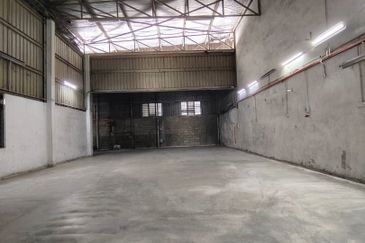
There seems to have been an increase in the number of opinion pieces and articles prognosticating a gloomy future for the Malaysian economy in 2019. While there are certainly economic challenges ahead driven by internal and external factors, the perception that the Malaysian economy will somehow crash and burn in 2019 is most certainly a false one. A closer examination of the underlying figures will demonstrate why this is the case.
Firstly, let’s look at the Nikkei Malaysia Manufacturing Purchasing Manager’s Index (PMI) which dropped to a low of 46.8 in December 2018. The PMI data is an important leading indicator of economic activity in the manufacturing sector. A figure above 50 shows that managers are increasing their orders and economic output whereas a figure below 50 shows that managers are depleting their existing stocks and not expecting to increase their future economic activity.
Nikkei Malaysia Manufacturing PMI (January to December 2018)
Figure 1 shows Malaysia’s PMI from January to December 2018. What is important to note is that the PMI fell for four consecutive months from January to May 2018. But the fall in the PMI in the 1st half of 2018 did not lead to any significant decreases in manufacturing output and value in the Malaysia economy. Indeed, the overall trend in the value of manufacturing sales in Malaysia showed a healthy increase from RM67.8 billion in January 2018 to RM73.1 billion in October 2018, which is an increase of 7.8%. Indeed, Figure 2 shows that the manufacturing sales for each month in 2018 exceeded the sales for the same month in 2017. There was no significant slowdown in manufacturing sales in 2018 despite the drop in the PMI for four consecutive months from January to May 2018.
Manufacturing sector sales value (RM billion) (January to October 2018 versus 2017)
At the same time, employment continued to grow steadily from 14.67 million in January 2018 to 14.94 million in October 2018 (an increase of 1.8%). Unemployment remained steady at 3.3% during this time period. (see Figure 3).
Employment (million) (January to October 2018)
Total trade figures also continue to show an increasing trend in 2018 compared to 2017. The total trade for each month in 2018 was higher than the corresponding month in 2017 (with the exception of February 2018). Exports for each month in 2018 was similarly higher than the corresponding month in 2017 (with the exception of August 2018).
Total trade and exports (January to November 2018 versus 2017)
Total trade (January to November 2018) has increased to RM1.72 trillion from RM1.62 trillion over the same time period in 2017, an increase of 6.2% (which is higher than the initial target of 5% growth set in early 2018).
Total exports (January to November 2018) have increased to RM914 billion from RM855 billion over the same time period in 2017, an increase of 6.9%.
Total balance of trade surplus (January to November 2018) has increased to RM109.6 billion compared to RM91.1 billion during the same time period in 2017, an increase of 20.2%.
Total trade, exports and balance of trade (surplus) (January to November 2018 versus 2017)
The challenge with depending too much on the Manufacturing PMI is that it is a business survey and the correlation with actual output may be weak. One could easily point to other business surveys which shows a more positive outlook for 2019. Accordingly to the Business Tendency Survey results for fourth quarter 2018 (4Q18), most establishments expect that business performance from October 2018 until March 2019 will be better compared to the period from April to September 2018 (with the exception of the construction sector).

Of course, the figures above do not mean that we can be assured of continuous growth in 2019, especially in the manufacturing sector. A slowdown in manufacturing growth may be imminent but the degree of the slowdown should be manageable, especially with the RM37 indirect stimulus via the goods and services tax and income tax refunds which should boost domestic consumption and investment. Most importantly, the figures do not show that Malaysia is heading towards a contraction in economic output anytime soon.
Secondly, the World Bank revised its growth forecast for Malaysia downwards from 5.4% (forecast in June 2018) to 4.9% (forecast in October 2018) for the year 2018. Any downward revision in economic growth is not good news for any country. But before we panic and make a hue and cry about this downward revision, we should try to understand the underlying factors involved. Bank Negara Malaysia had already revised gross domestic product (GDP) growth for 2018 to 5% earlier in August 2018, down from a forecast of 5.5% to 6%. The main reasons for this revision was the weakness in the commodity (notably palm oil) as well as mining sectors. Both these sectors experienced reductions in output in 2Q18. This trend continued in 3Q18 GDP figures.
Meanwhile, agriculture output fell by 2.5% in 2Q18 and by 1.4% in 3Q18 while mining and quarrying output fell by 2.2% in 2Q18 and 4.6% in 3Q18.

Changes in quarterly GDP (1Q18 to 3Q18) by sectors
It is important to note that the GDP figures for the manufacturing and services sector, which comprise almost 80% of the economy, are still registering healthy growth in all three quarters of 2018.
Whether the mining and quarrying sector can recover in 4Q18 and beyond remains to be seen. Production in Petronas’ operations in the Kebabangan gas fields, which were disrupted in 2Q18 and 3Q18, is expected to be fully revived only in August 2019. In the meantime, the recovery in the Industrial Production Index (IPI) for the mining sector in October 2018 to 105.3 looks encouraging, especially after dipping below 100 from June to September 2018.
Most analysts are also forecasting a recovery in gas production, especially in Sabah, if not in 4Q18 definitely in 2019.
The IPI figures for November 2018 (to be released on the Jan 19, 2019) and for December 2018 (to be released on Feb 19, 2019) and the 4Q18 GDP figures (to be released on Feb 19, 2018) must be closely monitored to see if the numbers of the mining and quarrying sector will rebound.
Industrial Production Index (IPI) for the mining and manufacturing sectors (January to October 2018)
This is not to say that there are no major concerns for the Malaysian economy moving forward in 2019. The Organisation for Economic Cooperation and Development has cut global growth projections from 3.7% to 3.5% in 2019 while UBS is projecting a global growth rate of 3.6%, down from an earlier estimate of 3.8% amid global uncertainties including interest rate hikes, political uncertainties in major economies and the possibility of further escalation of tensions in the US-China relationship. The World Trade Organisation has cut its global trade growth forecast from 4.0% in 2019 to 3.7%. The International Monetary Fund (IMF) has cut its 2019 growth forecast for China from 6.4% to 6.2%.

Given Malaysia’s exposure to the global economy, there is no doubt that Malaysia will be affected negatively by some of these global headwinds.
The World Bank has cut Malaysia’s GDP growth forecast for 2019 from 5.1% to 4.7% while the IMF has revised Malaysia’s growth rate in 2019 from 5% to 4.6%. But this is a far cry from raising fears that Malaysia is about to enter into a recession.
The mitigation measures which the Malaysian government can and will undertake to tackle these headwinds are the subject of another article.
But for now, it is important to remember not to panic without understanding the underlying numbers. A recession is nowhere in the horizon for the Malaysian economy.
This article first appeared in The Edge Financial Daily, on Jan 7, 2019.
TOP PICKS BY EDGEPROP

Kawasan Perindustrian Sungai Petani
Sungai Petani, Kedah

Taman Perindustrian Ringan Juru @ IKS Juru
Simpang Ampat, Penang























